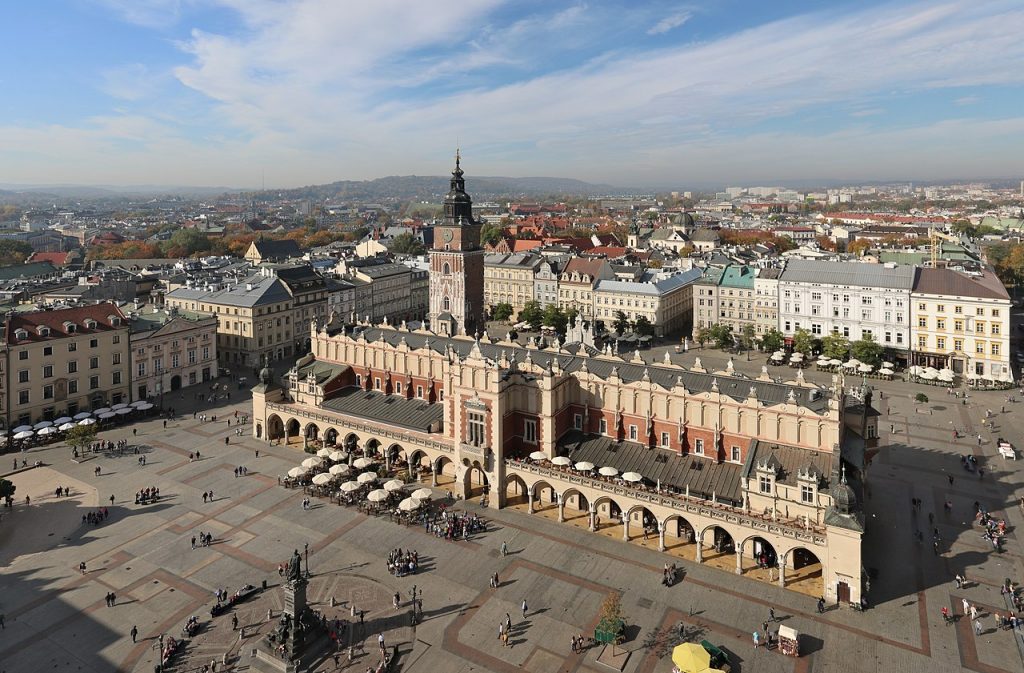
In 1335, King Casimir the Great founded an independent city near Kraków, Kazimierz, in which he permitted Jews to settle around Sukiernikow (Clothier) Street (now called Jozefa Street), next to the Christian quarter.
They built the Stara Synagogue, a mikvah, hotel, and wedding chapel on the main street called Szeroka (Wide) Street. In the sixteenth century, a large number of Jews arrived here from Bohemia. In 1553, Jews bought the land located between Waska (Narrow) Street and the city wall to construct houses, as well as a plot on Jakuba Street for the “Rema” cemetery and synagogue. At the time, three gates provided access to the Jewish quarter: one near the city wall and the Stara Synagogue, a second near the cemetery, and a third on Jozefa Street, between the Christian and Jewish areas. The Wysoka (High) Synagogue was later built near the third gate.
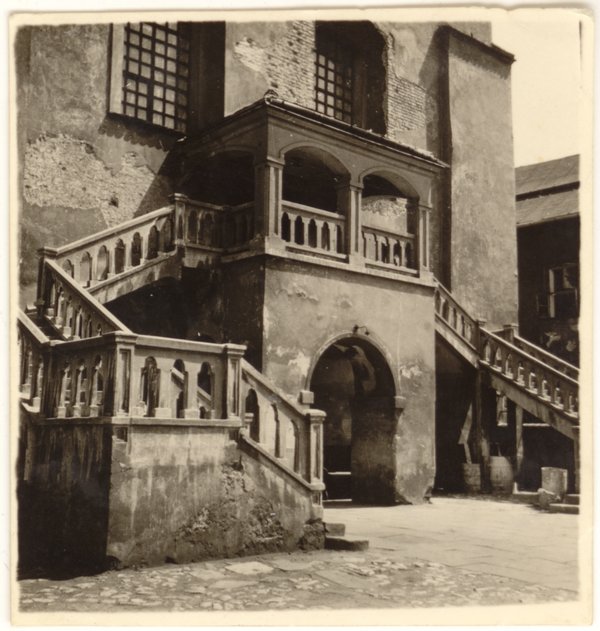
In 1564, the Jews obtained from King Sigismund August the privilege of non tolerandis christianis: the Christians were forbidden from buying plots of land of these streets and, conversely, Christian owners could not sell plot to anyone other than Jews. In 1635, all the land located of these few streets in Kazimierz was owned by Jews.
In the seventeenth century, the growth of the Jewish community required the building of a new synagogue: the Popper Synagogue on Szeroka Street, founded in 1920 by a rich merchant, Wolf Bocian; the Ajzyk Synagogue, named after Isaac Jakubowicz in 1644; and the Kupa Synagogue. At the time, Kazimierz was one of the largest Jewish cities in Europe, with 4,500 residents, as compared to the 5,000 in the city’s Christian section. As in Kraków, the wealthier Jews of Kazimierz had architects design new stone houses, and reconstruct the Stara Synagogue, destroyed by a fire in 1557.
After Poland was divided, Kraków and Galicia were annexed by Austria. In 1800, the Austrian government reunited Kazimierz and Kraków. In 1867, the Austro-Hungarian constitution pit an end to discrimination against Jews and even allowed them to freely choose their place of residence. The poorest and most religious Jewish remained in Kazimierz at the edges of the former ghetto. The more assimilated built a Reform synagogue, the Temple, on Miodowa Street, beyond these limits.
During the occupation, the Kraków ghetto suffered the same fate as the other Polish ghettos. It was liquidated in 1943, its inhabitants exterminated in Belzec or in the Plaszow camp. The Jewish quarter of Kraków, Kazimierz, is the best preserved of all in Poland, with considerable cultural value for tourists. Long neglected and repressed in Polish consciousness after the disappearance of its residents, it has reemerged as a valuable piece of Jewish heritage thanks to Steven Spielberg’s filming of Schlinder’s List here.
Since 1991, moreover, the city has ben putting on an annual Jewish cultural festival here, normally from June to July. To prepare your visit of Jewish Kraków, contact the Jewish community of the city.
Kazimierz
The tour begins on Miodowa (Honey) Street, accessed from Szeroka Street, the ghetto’s main street. At the intersection of these two street. At the intersection of these two streets stands the beautiful building that housed the old mikvah, dating back to 1567.
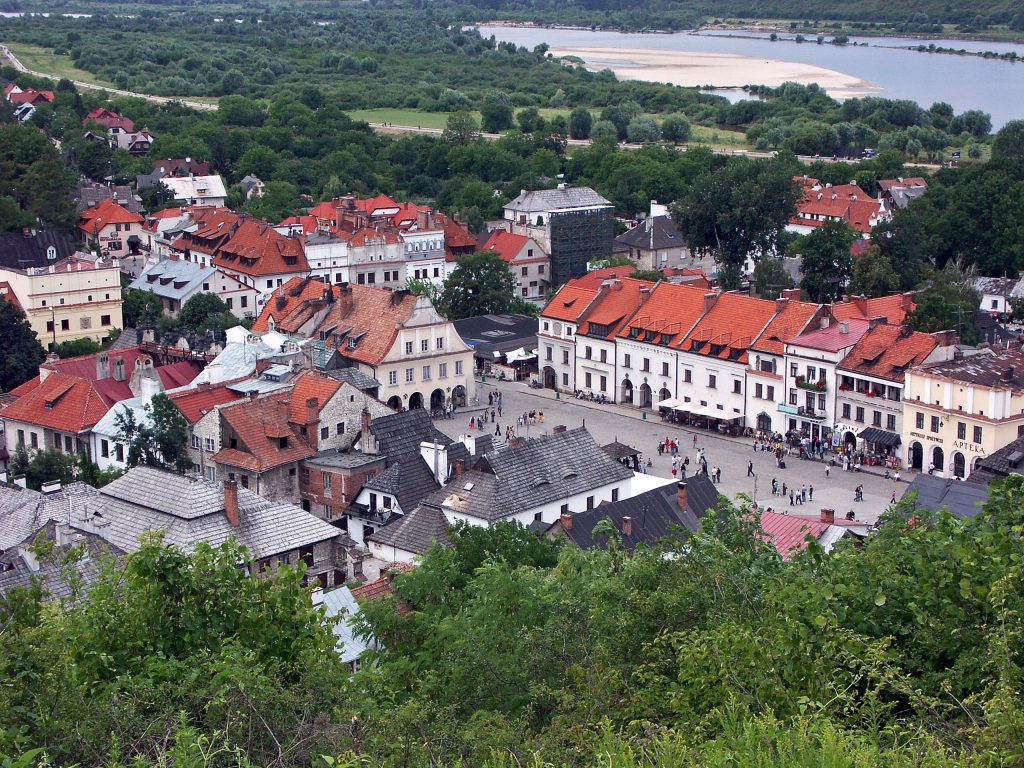
Szeroka Street is, in fact, a large, rectangular square, around which extend the majority of Jewish community buildings, houses, and Jewish restaurants, with the cemetery and the Rema Synagogue on the right, the Stara Synagogue straight ahead, and the Popper Synagogue on the left. At the center of the square a little park is surrounded by an enclosure featuring seven-branch candelabras. The rest of the square is now a parking lot.
The songs of Mordecai Gebirtig
Mordecai Gebirtig, born in Kazimierz in 1877, was the most talented of the Yiddish singer-author-composers of the twentieth century. He was a carpenter in the Kraków ghetto, where he was murdered in 1942. His nostalgic songs, like “Kinderyorn” (Childhood Years), still sounds in our ears. In 1938, he composed a premonitory song, “Unzer Stetl Brent” (Our Shtetl is Burning), which was to become a hymn for ghetto combatants: “It is burning, little brother it is burning ! / Oh, our poor shtetl is burning”.
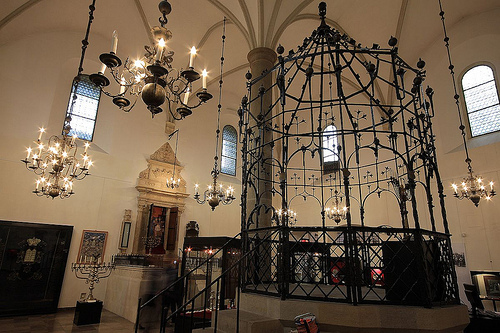
The Ancient Synagogue was built in Gothic style during the fifteenth century and inspired by synagogues in Worms, Prague, and Ratisbon. It was reconstructed in Renaissance style following a design by the Florentine Matteo Gucci after a fire in 1557. Today it houses the Kraków Jewish History and Culture Museum. Not far from it, you can find the Museum of Galicia which gives tribute to the Jewish cultural heritage of the region. It was created thanks to the initiative of a British photograph and inaugurated in 2004. Exhibits about Jewish life are shown there.
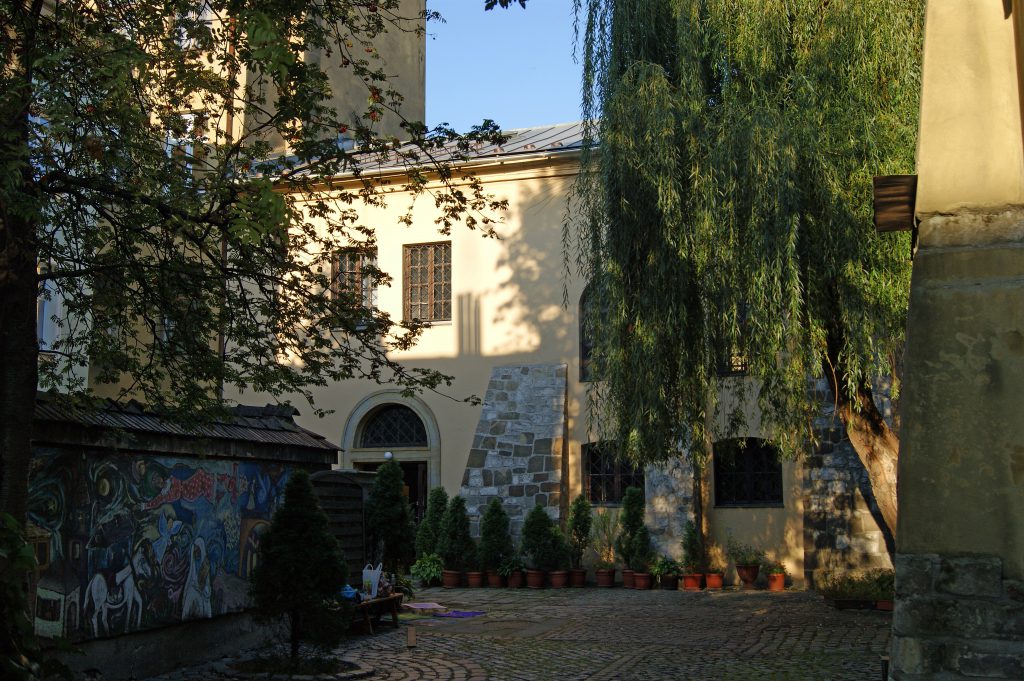
The magnificent interior perfectly recreates the atmosphere of an old synagogue, especially with the circular wrought iron bimah in the center, a sort of temple within a temple. To the sides and in the rooms adjacent to the prayer area, works of art and religious objects are on display, as well as photographs depicting old Kazimierz.
Founded in 1620, the old Popper Synagogue is located behind the courtyard. It was destroyed during the war, the reconstructed, and finally converted into an art center for children and adolescent. At the entrance to the synagogue courtyard are located the Ariel café-gallery and a Jewish restaurant-café.
The Landau House dates back to the fourteenth century, one of the oldest and largest stone houses of the former ghetto. Its architecture is distinctive and immediately attracts attention. Inside, there is a café and the Jarden Jewish bookstore, which offers guidebooks to Kazimierz and organizes guided tours of locations filmed for Schlinder’s List.
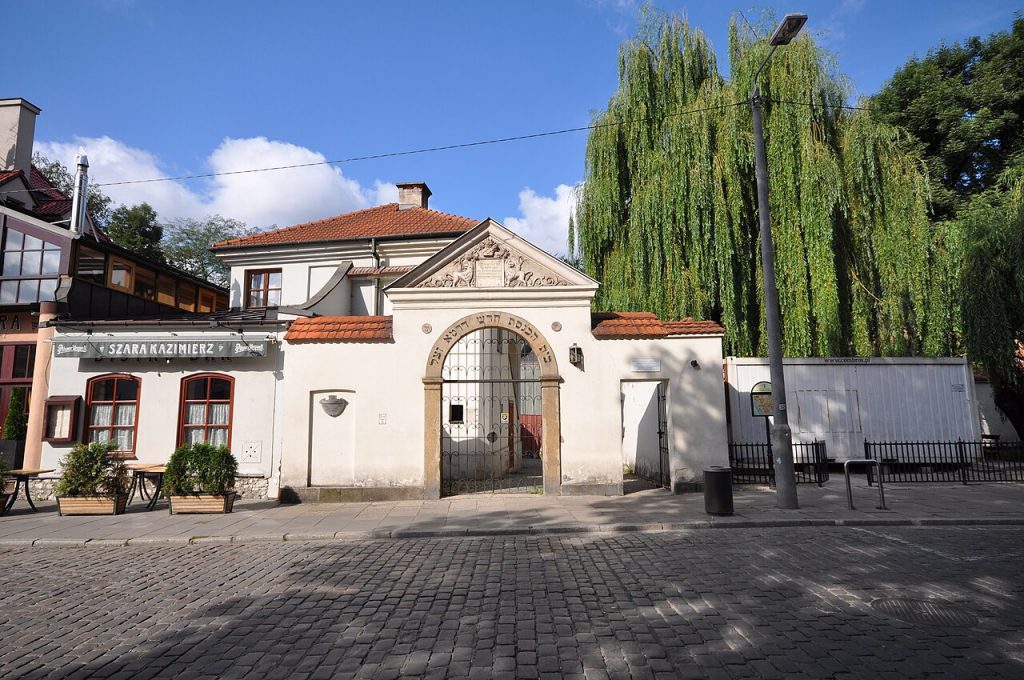
The Rema Synagogue was founded in 1553 by Israel ben Josef Isserles, who hailed from Ratisbon. It bore the name of his son, philosopher and famous rabbi Moses Isserles (1525-72), also known as Reb Moses or Rema. Its monumental front door is also that of the cemetery! With the latter, this synagogue in fact forms an important fifteenth-century Jewish architectural ensemble, comparable to the Altneuschul and cemetery in Prague. Inside, it is relatively small. It, too, possesses an interesting wrought iron bimah. Besides the one in Lublin, this is the oldest Jewish cemetery in Poland, and worth a careful visit.
Here one finds numerous graves of personalities famous in their time, notably those of Moses Isserles and his family, but also Eliezer Achkenazi, a rabbi in Cairo and later Poznan; rabbi and Kabalist Nathan Spira; and Yomtov Lipman Heller, a rabbi in Vienna, Prague, Nemirov, and finally yeshiva director in Kraków. The grave of Moses Isserles, just behind the synagogue, is one of the most remarkable: it is covered with small stones that visitors leave as a sign of tribute. A bit further on, the cemetery rises up, forming a hill, which is, in reality, an accumulation of tombs. The cemetery wall, near the entrance, is made up of concrete gravestones.
Taking Szeroka Street to its end, you will reach Jozefa Street, where, at number 38, across from a small square at the intersection with Waska Street, stands Wysoka (High) Synagogue , its name owing to the second-floor location of its prayer room. Built between 1556 and 1563, it was destroyed by the Germans, rebuilt after the war, and donated as a historical monument. Despite, its beautiful exterior, nothing much remains inside.
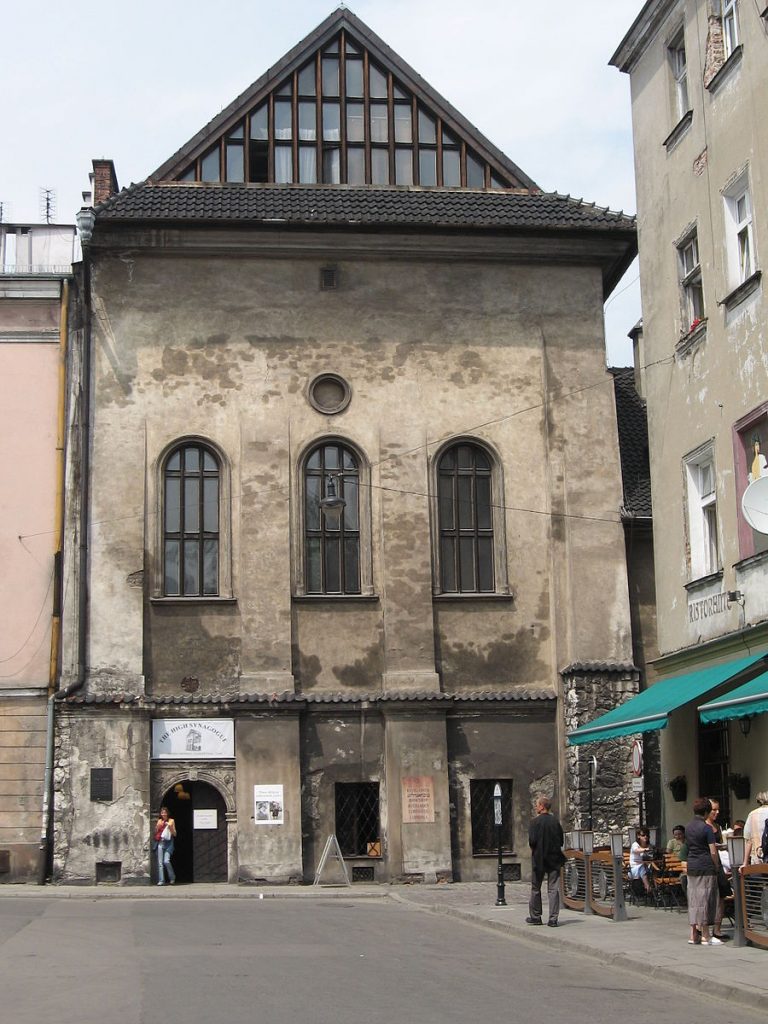
From Jakuba Street can be seen the back side of the impressive Ajzyk Synagogue , at the intersection with Izaaka Street facing the cemetery wall. Founded by rich merchant Isaac Jakubowicz (also known as Reb Ajzyk ben Jekeles), it dates to 1638. Its facade and monumental staircase face Kupa Street. Destroyed by the Germans but now rebuilt, it is a place of memory featuring an exhibit about Polish Jews. Films about Kazimierz are also shown here.
The Kupa Synagogue is located on Warzauer Street at the end of Kupa Street. Built in the early seventeenth century at the site of the ghetto’s outside wall, it is recently restored. It contains beautiful paintings depicting the cities of Palestine. Further on is the very picturesque New Square (Nowy Targ), also called Jewish Square, where a circular covered market , or okraglak, has been set up and where ritual slaughter was at one time performed.
The Talmud Torah school used to be at 6 Estery Street.
Continuig on to Meiselsa Street, the magnificent interior courtyard of ber 15, featuring galleries running through the second floor and a porch overlooking Jozefa Street. In the background looms the bell tower of the Church of Corpus Christi. A courtyard entered at Jozefa 12 Street was the location of a scene from Schlinder’s List.
From Bozego Ciala Street, Miodowa Street leads to the Reform Templ Synagogue (at the intersection with Podbzezi Street), which is remarkable for its beautiful stained-glass windows.
Behind the railroad tracks on the other side of Miodowa Street is the new Jewish cemetery . It was built in 1800 after the Rema cemetery was closed. Its extensiveness recalls the large Jewish community that was here before the war. At the entrance, a monument assembled from numerous gravestones and commemorative plaques has been put up in memory of the victims of the Shoah.
By taking Starowisla Street, on the other side of the Vistula, you will reach what used to be the ghetto during the German occupation, around Bohaterow Getta (Heroes of the Ghetto) Square and Lwowska, Josefinska, and Limanowskiego streets. A museum is located in the Pod Orlem pharmacy , whose owner, Tadeusz Pankiewicz, greatly helped the Jews of the ghetto. On Lwowska Street a fragment of the ghetto wall can be observed, resembling an alleyway of gravestones.
Further on, in Plaszow (on Kamienskiego Street), a monument stands in honor of the victims deported from the Kraków ghetto to the concentration camp built on this very spot.
The JCC was officially opened in 2008 by the Prince of Wales. The centre provides social and educational services to Krakow’s Jewish community. But it also has different objectives. Firstly, to contribute to the resurgence of Jewish life in Krakow and to foster Polish-Jewish relations. To this end, it was also important to provide a symbolic location in the heart of the city’s historic Jewish quarter, Kazimierz. The Jewish Community Centre has always been very involved, but with Russia’s war in Ukraine, its role has evolved well beyond the cultural and social, particularly helping Ukrainian refugees following Russia’s war in their country.
The JCC and its partners helped over 80,000 Ukrainians in the first four months of the Russian onslaught, and continue to do so. They include refugees who have fled to Poland as well as Ukrainians on the other side of the border, regardless of their cultural or religious background. The JCC serves as a distribution point for food, medicine, toys, clothing, etc.
On 26 January 2025, a ceremony was held to mark the 80th anniversary of the liberation of Auschwitz, attended by 17 survivors. The importance of passing on the memory was underlined, as were fears of the exponential rise in anti-Semitic acts around the world since the pogrom in Israel on 7 October 2023.